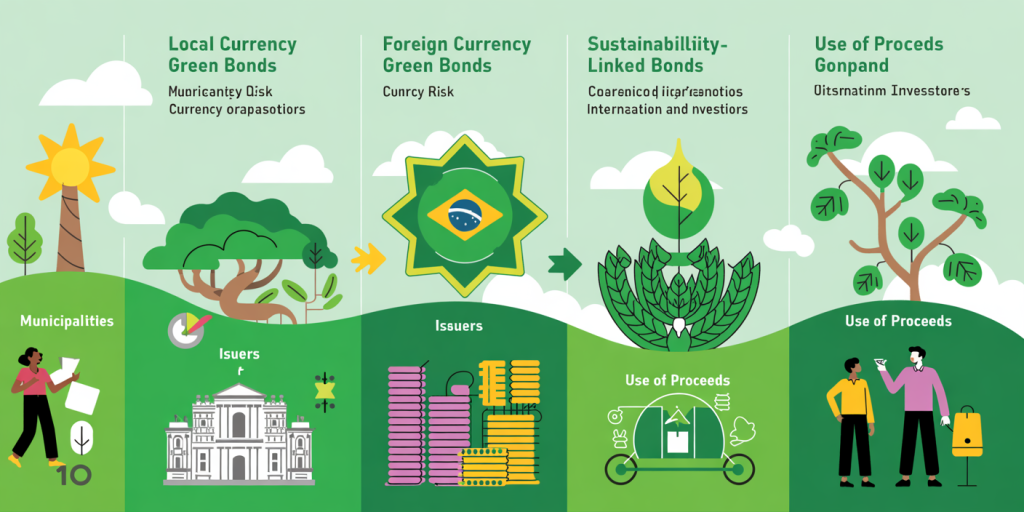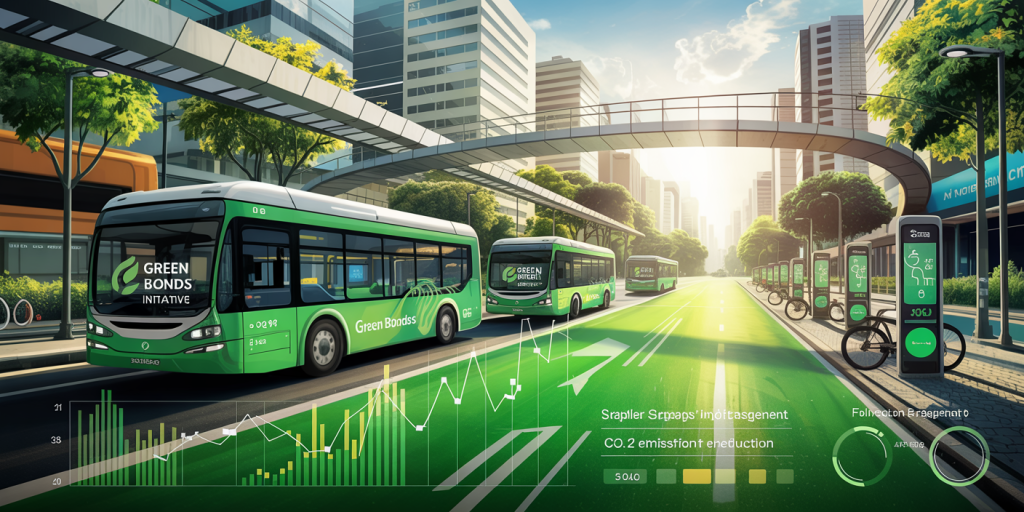Green Bonds: How to Invest Sustainably in Brazil
Sustainable investment is rapidly gaining momentum worldwide, driven by growing awareness of climate change and environmental impacts. In Brazil, a country rich in natural resources and biodiversity, sustainable finance tools such as green bonds are becoming crucial for funding projects that align economic growth with environmental preservation. Green bonds offer investors a unique opportunity to support projects addressing climate risks while earning competitive returns.
Understanding Green Bonds in the Brazilian Context
Green bonds are debt securities issued to finance projects with clear environmental benefits—ranging from renewable energy installations to sustainable agriculture, clean transportation, and water management. Unlike conventional bonds, green bonds come with frameworks that require transparency in the use of proceeds, ensuring funds directly benefit environmental initiatives.
Brazil has emerged as a leader in green bond issuance within Latin America. According to the Climate Bonds Initiative, Brazil accounted for approximately 35% of Latin America’s green bond issuance in 2023, totaling around USD 2.6 billion. This reflects both the government’s commitment and private sector interest in financing sustainable infrastructure projects. The Brazilian Development Bank (BNDES) and major corporations like Natura and Braskem are prominent issuers, supporting projects that reduce carbon footprints and promote biodiversity.
The Brazilian green bond market benefits from the country’s abundance of renewable energy sources such as solar, wind, and hydroelectric power. Additionally, Brazil’s vast forests, especially the Amazon, provide high-impact opportunities for reforestation and forest conservation projects that align well with the green bond criteria.

Types of Green Bonds Available to Brazilian Investors
Investors in Brazil can access several types of green bonds, both in the domestic market and through international issuances: Local Currency Green Bonds: Issued in Brazilian reais (BRL), these bonds reduce currency risk for Brazilian investors and help fund domestic projects. For example, in 2022, the municipality of São Paulo issued BRL 500 million in green bonds to finance sustainable urban transport and waste management. Foreign Currency Green Bonds: Issued in USD or EUR, often by multinational Brazilian companies or development banks. For instance, Vale, a multinational mining company, issued a USD 500 million green bond in 2021 to fund nickel and copper projects aligned with environmental standards. Sustainability-Linked Bonds: While not strictly green bonds, these bonds tie the issuer’s financial costs to sustainability targets, such as reducing greenhouse gas emissions.

A comparative table below illustrates key features of these green bond types:
| Feature | Local Currency Green Bonds | Foreign Currency Green Bonds | Sustainability-Linked Bonds |
|---|---|---|---|
| Currency Risk | Low for Brazilian investors | Higher due to exchange rate | Varies based on issuance |
| Use of Proceeds | Restricted to green projects | Restricted or broad sustainability | Linked to sustainability targets |
| Common Issuers | Municipalities, local companies | Multinational firms, banks | Various sectors |
| Accessibility | Domestic investors preferred | Global investors | Global investors |
| Typical Maturity | 5-10 years | 7-12 years | 5-10 years |
Evaluating Environmental Impact and Risks
A critical aspect of investing in green bonds is evaluating the environmental integrity of the projects financed. Brazil’s green bond issuers typically follow recognized frameworks such as the International Capital Market Association’s Green Bond Principles (GBP) or use certification schemes like the Climate Bonds Standard. These frameworks require issuers to provide detailed reports on project impact, use of proceeds, and environmental benefits.
For example, the 2023 issuance by BNDES was certified under the Climate Bonds Standard, financing wind and solar projects aimed at increasing renewable energy capacity by 500 MW. Independent third-party verification ensures that the financed projects contribute measurably to reducing carbon emissions and conform to robust environmental standards.
However, investors should also be aware of potential greenwashing risks, where funds may be allocated to projects with dubious environmental benefits. Transparency, clear disclosure, and third-party assurance reports are essential tools to mitigate such risks. Brazil’s growing environmental regulations and public scrutiny increase accountability, but due diligence remains crucial.
Investment Returns and Market Performance
One concern often raised by investors is whether green bonds offer competitive returns compared to traditional bonds. In Brazil, market data shows that green bonds have performed well, with yields comparable or slightly better than equivalent conventional bonds.
For instance, a 2022 analysis by XP Investimentos revealed that green bonds issued by Brazilian corporates yielded an average coupon rate of 8.1% annually, while similar maturity conventional bonds averaged 7.7%. The slight premium reflects growing demand and investor confidence in sustainable projects. Moreover, green bonds tend to attract a broader investor base, including ESG-focused funds, potentially increasing liquidity.
Risk factors influencing returns include project-specific risks (e.g., regulatory changes or delays), currency volatility for foreign-issued bonds, and broader economic factors. Brazil’s relatively stable inflation and interest rates have made green bonds an attractive option for fixed income investors seeking exposure to sustainability themes.
How to Access Green Bond Investments in Brazil
For individual and institutional investors interested in green bonds, several practical options exist in Brazil: Bond Funds and ETFs: Funds focusing on ESG and sustainable fixed income often include Brazilian green bonds. For example, the XP ESG Green Fixed Income Fund invests in a diversified portfolio of green bonds issued by Brazilian companies and municipalities. Direct Purchase through Brokerages: Investors can buy individual green bonds via brokerage platforms that list Brazilian fixed income securities. This route requires understanding bond terms and project specifics. Participating in International Markets: Through Brazil-based custodians or international brokers, investors can access foreign currency green bonds issued by Brazilian multinationals.
To illustrate various accessibility options, here is a hypothetical comparison of three investment paths:
| Investment Mode | Minimum Investment | Liquidity | Risk Level | Transparency |
|---|---|---|---|---|
| Green Bond Funds | BRL 1,000 | High (daily liquidity) | Medium | High (professional management) |
| Direct Bond Purchase | BRL 5,000 or more | Medium (depends on market) | Medium-High | Variable (depends on issuer reports) |
| International Bonds | USD 10,000 approx. | Medium | Currency risk + Project risk | High (usually verified) |
Successful Green Bond Projects in Brazil
Several green bond financings in Brazil exemplify the positive impact and investment potential these instruments offer: Natura & Co (2021): The cosmetics giant issued a USD 200 million green bond to finance sustainable packaging innovations and waste management projects. Natura’s commitment helped reduce plastic usage by 25% within two years and inspired other companies in the FMCG sector to adopt green financing. São Paulo’s Sustainable Transport Initiative (2022): The issuance of BRL 500 million green bonds funded the expansion of electric bus fleets and improvement of bike-sharing infrastructure, resulting in a 15% reduction in urban CO2 emissions in targeted districts. BNDES Renewable Energy Projects: Through multiple green bond issuances, BNDES has facilitated over 1 GW of new renewable capacity, aiding Brazil’s goal of reaching 45% renewable energy in its electricity matrix by 2030.

These examples demonstrate the tangible environmental and social benefits achieved, alongside financial viability for investors.
Future Outlook for Green Bonds in Brazil
Brazil’s green bond market shows strong potential for growth in the coming years. The country’s Nationally Determined Contribution (NDC) under the Paris Agreement commits to reducing greenhouse gas emissions by 43% by 2030, implying robust demand for financing green projects.
Moreover, regulatory improvements such as the Brazilian Securities Commission (CVM) guidelines on ESG disclosures and incentives for sustainable investments are likely to enhance market maturity and investor confidence. The forthcoming integration of social and sustainability bonds alongside green instruments is expected to broaden investment opportunities.
Emerging sectors such as sustainable agriculture, reforestation projects, and climate-resilient infrastructure stand to benefit from green bond financing. Furthermore, increased participation from global ESG funds and fintech platforms could democratize access for retail investors.
Finally, technological advancements in blockchain and digital certification may improve transparency and verification processes for green bonds, reducing greenwashing risks and improving market credibility in Brazil.
—
Green bonds represent a powerful tool for Brazilian investors seeking to align their portfolios with sustainability goals while supporting essential climate and biodiversity initiatives. By understanding the types of bonds available, evaluating environmental impact, and considering market dynamics, investors can make informed decisions that contribute to Brazil’s sustainable development and global climate commitments.
